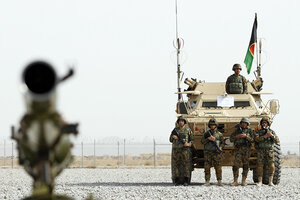Why is more data on Afghanistan war being classified, former US commanders ask
Former military commanders are concerned the move will prevent Americans interested in tracking the conflict's progress from accessing information that has been readily available. The US command in Afghanistan has cited security reasons.

Afghan National Army soldiers stand guard next to a military vehicle in an army station during a ceremony in Kandahar, Afghanistan, Jan. 11, 2015.
Allauddin Khan/AP
Washington
US military commanders have decided to classify some basic information about how the war in Afghanistan is going – from how much the United States spends on weapons for Afghan troops to their rate of desertion.
Now former military commanders are speaking out against the move. They're concerned that it will prevent Americans interested in tracking the progress of the nation’s longest conflict – from congressional staffers to active-duty troops and veterans – from accessing information that has been readily available for the past six years.
“I find it ridiculous,” says retired Col. Peter Mansoor, former executive officer to retired Gen. David Petraeus in Iraq. “These figures help the American people focus on where their money is being spent – and whether it is being spent wisely.”
Though the US command in Afghanistan has cited security reasons, “I’m hard pressed to think of a legitimate reason to classify it at this stage of the game,” says retired Lt. Gen. David Barno, commander of US forces in Afghanistan from 2003 to 2005. He believes the move has “more to do with avoiding the public pain that comes with some of this scrutiny.”
The move came to light Thursday in a report from the war’s chief government watchdog, the Special Inspector General for Afghanistan Reconstruction (SIGAR). It decried the decision to classify nearly all key data related to the US military’s central mission in Afghanistan, which is training the Afghan National Security Forces (ANSF).
“The decision leaves SIGAR unable to publicly report on most of the $65 billion US taxpayer-funded efforts to build, train, equip, and sustain the ANSF,” the report notes. “This includes Afghan troop numbers, salaries, training, equipment (including planes and helicopters), and infrastructure projects.”
Gen. John Campbell, commander of US forces in Afghanistan, told SIGAR that he could no longer publicly answer more than 140 of SIGAR’s questions, because they related to “operationally-sensitive information.”
“I have directed that sensitive operational information or related materials that could be used by those who threaten the force, or Afghan forces, be classified at an appropriate level,” he wrote to SIGAR. “With lives literally on the line, I am sure that you can join me in recognizing that we must be careful to avoid providing sensitive information to those that threaten our forces.”
But the information isn’t sensitive, former military commanders say. SIGAR asks, for example, that the US command provide:
- The total amount of funding that the US has spent on Afghan Army food.
- How the $25 million authorized by Congress to integrate women into the Afghan Army has been used.
- The total amount the US has spent on Afghan police salaries for the current year.
General Campbell told the Monitor in an e-mail that he made the decision to classify the data in August shortly after he took command.
The government of Afghanistan also requested that US forces not publicly disclose the readiness data for Afghan forces, he adds.
“I, and in fact all of the coalition (and the Afghans, too) appreciate, understand, and support SIGAR’s responsibility to provide information to Congress and the American public,” he says. “At the same time, we have a responsibility to protect data that could jeopardize the operational security of our Afghan partners to include unnecessarily highlighting possible vulnerabilities and capability gaps.”
Though there may be some of these vulnerabilities – naming, say, a particular Afghan unit in a particular town that is grappling with desertion might inspire a Taliban attack – many of these statistics, like the ones above, do not come with such concerns, former military officials say.
“We were always very critical of overclassifying information, which is an endemic problem in DOD,” Mr. Barno says. He adds that it would not take a military intelligence staffer long to pick out the few facts that might point to specific vulnerabilities.
So why classify the data now? Some former military officers have their own theories.
“If the Afghan forces are failing in terms of maintaining readiness standards, it puts pressure on the administration to do something about it,” says Mr. Mansoor, who is now the chair of military history at Ohio State University in Columbus. “If this is all just out of view, it’s out of sight, out of mind.”
The lack of feedback from the US public will only harm the war effort, says Barno, who is now a distinguished practitioner in residence at American University’s School of International Service in Washington.
“It’s painful as a commander to get negative feedback. No commander likes it,” he adds. “But there’s an immense value to having another set of eyes on the problem – like the free press, like the American public – and not just your own.”

